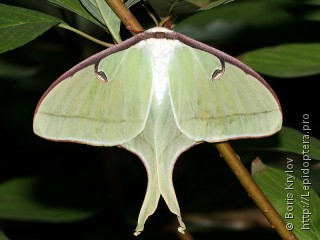Ohio moths: Actias luna, the Luna Moth
Community and Forum → Blog → Ohio moths: Actias luna, the Luna Moth
Lev Bely, 21.06.2012 22:21

Moths are as marvelously diverse as wrongly misattended. They get rare minutes of fame when we enjoy our tea outside in summer accompanied by their shadows fluttering around lights. In fact, in the animal world those slight shadows play a role way far from slight. Each adult butterfly or moth leaves behind lots of caterpillars which had to turn into not an imago but the vital food for songbirds, beetles, wasps and other predators. Barely few of caterpillars are lucky to reach the imago stage and even then those trying to spread their brand new wings are a long awaited dinner for bats, birds and legless flycatchers.
In the state of Ohio, USA, there are about 2500 moth species which can be met here and there. Most of them wouldn't even try to engage in beauty pageants just as no one but a few truly keen entomologists could pay them some attention. Yet there are as well local “superstars”, which beauty makes anyone stop and gaze at.
Giant silkworm moths are most popular in Ohio. There are 18 species of Saturniidae family, and these huge, bright moths are always a special sight. The biggest can be of bat size like the Cecropia Moth (Hyalophora cecropia) with a 15cm wingspan. Nearly of the same size is the beautiful pastel green Luna Moth (Actias luna) — one of the most recognizable moths of Northern America due to its high popularity.
The luna moth begins its life in one of 300 eggs laid by a female on an apposite feed plant. Those apposite include four tree species such as cherry, beech, hickory and walnut. 10 days after tiny caterpillars hatch from eggs and start eating foliage. Every week the caterpillar exuviates, in other words, throws off its skin, and gets bigger. This takes 5 times (ages), after that the luna caterpillar gets to the adult stage. The mature caterpillar is large, brightly green, about 7,5cm length, it has clawed bearlike legs, vivid orange spots longwise and bundles of stiff hairs.
Soon the mature caterpillar forms a cocoon and then overwinters, in case it happens in the end of the summer. In cocoons formed at the beginning of the season, caterpillars spend two weeks to eventually transform into a luna moth of a spectacular beauty. Once seen, this apple-green tailed moth is pretty hard to forget. Its large forewings are fringed with a deep purple-brown stripe whilst hind wings end with a swanky double tail with tips slightly curled.
How come such a gorgeous thing doesn't fall victim at the very first hours of its life? It gets clear if to look at it from above: you can discern... a tree branch with swelling buds and leaves-wings which are all actually that very luna moth.
It lives nothing but a week, just to mate and lay eggs. It has reduced mouth parts so doesn't feed. Males are fashioned with great feathery antennae interspersed with sensitive receptors which are even more responsive than a bloodhound's nose. That's why males are capable to catch female pheromones more than 1,5 km away.
Luna moths couple at night, and then there will be new generations of the luna just as other moths of the same amazing beauty — in Ohio and everywhere.
The Columbus Dispatch, http://www.dispatch.com
Photo: the Luna Moth, A. luna
http://www.youtube.com/watch?v=atOSro3_W7c
All the rest posts on: curiosity, USA
Comments
New comment
Note: you should have a Insecta.pro account to upload new topics and comments. Please, create an account or log in to add comments.
* Our website is multilingual. Some comments have been translated from other languages.
Random species of the website catalog
News
- 02.03.2025: Moscow Insect Fair: New section on the Insecta.pro Website
- 31.12.2024: If you need to upload a lot of photos to Insecta.pro website
- 10.12.2024: Новое поле в «Поиске энтомологов»
New photos (28.03.2025)
Fresh from the community
- 23:09, M. Niobius: Здравствуйте. Тульская область, окт...
- 12:52, L. Bolshakov: Петр, см. там подробности: https://...
- 12:32, P. Khramov: Лавр, источник скиньте, пожалуйста....
Popular insects
Recommended blog topics
- ICZN Election of Commissioners
- Interview with Alexander Zatakovoy, one of the wild Russian entomologists
- Streets: insects names
- Butterflies and music: Andrei Khrzhanovsky, Butterfly



























